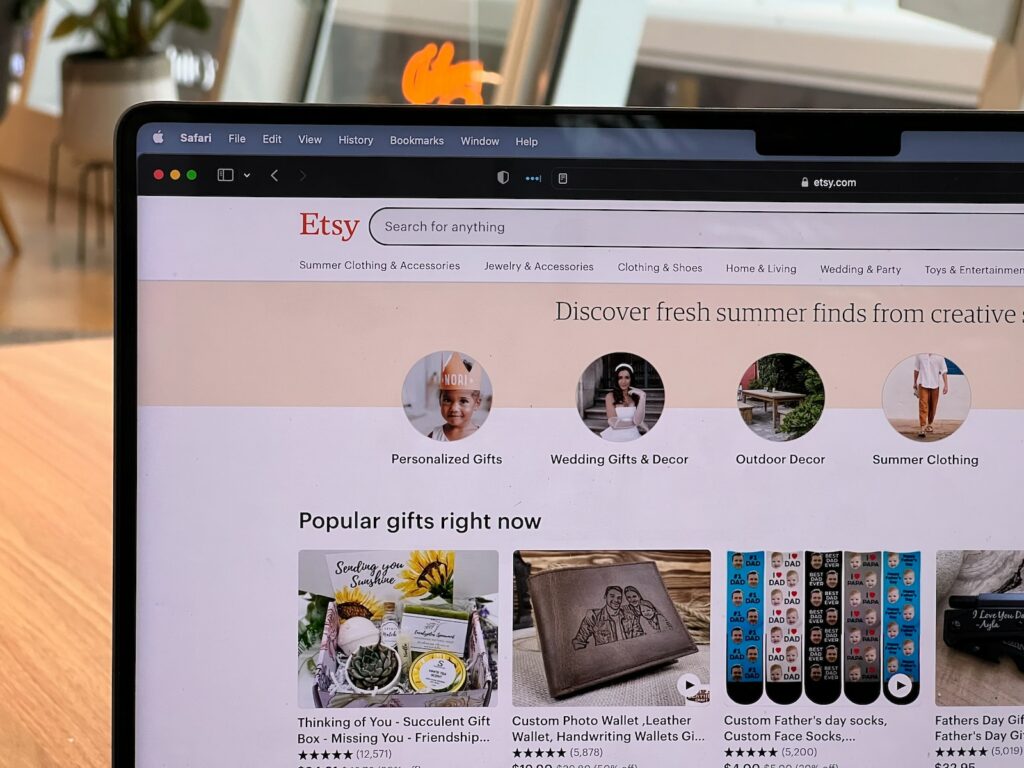Welcome to our blog on turning your photos into beautiful prints! If you’re a photographer looking to showcase your art in a tangible and sellable form, you’ve come to the right place. In this step-by-step guide, we will cover everything you need to know – from selecting the perfect photos to ensuring top-notch print quality, and even explore various avenues for selling your prints. So, grab your camera and let’s get started on this exciting journey of transforming your photography into stunning prints.
Table of Contents
- Step 1: Selecting the Perfect Photos
- Step 2: Showcasing and Selling Your Prints
- Step 3: Marketing and Promoting Your Prints
- Start Selling Your Art Today!
- Turning Your Photos into Prints: A Step-by-Step Guide
- Frequently Asked Questions
- 1. How can I turn my photos into prints?
- 2. What factors should I consider in print quality?
- 3. Where can I sell my prints?
- 4. How can I promote my prints to attract buyers?
- 5. What are some tips for pricing my prints?
- 6. How can I ensure my prints are protected during shipping?
- 7. Should I offer limited edition prints?
- Wrap Up
Step 1: Selecting the Perfect Photos
Before you dive into the world of selling prints, it’s essential to curate a captivating collection of photos. Choose images that speak to you personally and have the potential to resonate with others. Look for striking composition, unique perspectives, and captivating subjects that evoke emotions. Remember, your selection is what will capture the attention of potential buyers.
Choosing the Right Print Quality
Once you’ve chosen your best shots, it’s important to ensure that the quality of your prints lives up to your artistic vision. Investing in high-quality printers, inks, and papers will result in prints that truly represent the essence of your photographs. Experiment with different paper finishes, such as glossy or matte, to find the perfect fit for each image. Don’t compromise on print quality – it can significantly impact how your work is perceived.
Exploring Print Sizes and Formats
Consider the purpose and target audience for your prints when deciding on sizes and formats. Large prints can make a bold statement, while smaller ones may appeal to collectors of limited wall space. Exploring various formats, such as framed prints, canvas wraps, or even photo books, can add versatility and options for different buyer preferences. Variety will help cater to a broader market and increase your chances of making sales.
Step 2: Showcasing and Selling Your Prints
With your carefully selected and expertly printed photos in hand, it’s time to explore avenues for selling your artwork. Here are some strategies to get your prints out into the world and generate interest:
Setting Up an Online Store
An online store gives you the freedom and flexibility to reach a global audience. Create a visually compelling website that showcases your prints and allows customers to place orders directly. Optimize your store for search engines, using keywords like “selling prints” and “photography,” to attract organic traffic and increase visibility.
Utilizing E-commerce Platforms and Marketplaces
Don’t limit yourself to just your website. Utilize popular e-commerce platforms and marketplaces that cater to artists and photographers. Platforms like Etsy, Society6, and Fine Art America provide exposure to a large customer base and offer tools to market your prints effectively. Research these platforms to find the best fit for your specific style and target audience.
Collaborating with Local Businesses and Galleries
Establish connections with local businesses, art galleries, or cafes that may be interested in showcasing your prints. Collaborating with such establishments not only provides exposure but also enhances the credibility and value of your work. Participate in art exhibitions or join local photography groups to network and explore potential partnerships.
Step 3: Marketing and Promoting Your Prints
Creating exceptional prints is just the beginning; marketing and promotion are key to gaining visibility and attracting potential buyers. Here are some effective strategies to consider:
Harnessing the Power of Social Media
With a vast audience on platforms like Instagram, Facebook, and Pinterest, social media is a powerful tool for photographers. Post regularly, engage with your followers, and use relevant hashtags to increase your reach. Share behind-the-scenes glimpses, stories behind your photos, and even offer exclusive discounts to cultivate a loyal community of supporters.
Collaborating with Influencers and Bloggers
Partnering with influencers and bloggers who share your target audience can greatly expand your reach. Offer them complimentary prints in exchange for authentic reviews or features on their websites or social media channels. Their endorsement can generate buzz and introduce your work to new, interested buyers.
Optimizing Your Online Presence with SEO
Ensure your website, online store, and blog are optimized for search engines by incorporating relevant keywords throughout your content. Focus on phrases like “selling prints,” “photo prints,” “print quality,” and “photography.” By ranking higher in search engine results, you’ll increase the chances of attracting organic traffic and potential customers.
Did you know that the first photograph ever taken was in 1826 by Joseph Nicéphore Niépce? It required an exposure time of several hours!
Start Selling Your Art Today!
Now that you have a comprehensive guide to turning your photos into prints, it’s time to embark on this exciting journey. Remember, creating captivating prints is not only a delightful way to showcase your art but also opens doors to a wider audience and potential revenue stream. So, select your best photos, invest in print quality, explore different selling platforms, and market your prints effectively. Start turning your passion for photography into a thriving print business today!
Turning Your Photos into Prints: A Step-by-Step Guide
Are you a passionate photographer who wants to share your beautiful images with the world? It’s time to turn your photos into prints and start selling your art! This step-by-step guide will help you navigate through the process, from selecting the right photos to finding the best places to sell your prints.
Step 1: Selecting Your Photos
Begin by carefully curating a collection of photos that you believe will capture the attention of potential buyers. Focus on images that showcase your unique style and evoke emotions. Remember, quality matters, so choose photos that are sharp, well-composed, and visually appealing.
Transition: Once you have selected your photos, it’s time to ensure the print quality matches the beauty of your images.
Step 2: Ensuring Print Quality
Print quality plays a crucial role in selling your art. Invest in a high-quality printer or opt for professional printing services that offer excellent color accuracy and sharpness. Don’t forget to calibrate your monitor to guarantee that the colors in your photos are accurately represented in print.
Transition: Now that you have top-notch prints, it’s time to explore the various platforms where you can sell your art.
Step 3: Finding the Right Platforms to Sell Your Prints
There are countless online marketplaces and platforms dedicated to selling art and photography prints. Research and evaluate each platform to find the perfect fit for your work. Here is a comprehensive list of websites where you can sell your photos online, along with some key descriptions and benefits for each one:
- iStock Photo: This is one of the most popular stock photo websites, owned by Getty Images. You can sell your photos to a large and diverse customer base, and earn royalties ranging from 15% to 45%, depending on your exclusivity status. You can also join the Signature+ program, which gives you higher exposure and sales potential.
- Shutterstock: This is another leading stock photo website, with over 200 million images, videos, and music tracks. You can earn up to 30% of the sale price of your photos, depending on the size and license type. You can also earn more by referring other photographers or customers to the site.
- Alamy: This is a stock photo website that boasts the world’s most diverse collection, with over 313 million images, vectors, videos, and 360-degree panoramic images. You can sell anything from everyday images to specific niches, and receive up to 50% of direct sales if your images are exclusive with Alamy. There are no long-term contracts or exclusivity requirements with Alamy.
- 500px: This is a community-based platform for amateur and professional photographers. You can sell your photos through the 500px Licensing program, which distributes your images to partners like Getty Images. You can earn up to 100% royalties if you are a paid member, or up to 60% for non-exclusive photos if you are a free user. You can also participate in Photo Quest competitions for prizes and exposure.
- SmugMug Pro: This is a website that allows you to create your own online store to sell your photos. You can set your own prices and keep 85% of the markup. You can also choose from a variety of print products, such as canvas, metal, acrylic, and more. SmugMug Pro also provides unlimited storage, custom domain names, and marketing tools.
- Etsy: This is a popular online marketplace for handmade and vintage goods. You can sell your photos as prints, posters, cards, or digital downloads. You can also create your own brand and style, and reach a large audience of buyers. Etsy charges a small listing fee of $0.20 per item, and a 5% transaction fee on the sale price.
- Adobe Stock: This is a stock photo website that integrates with Adobe’s Creative Cloud software, such as Photoshop, Illustrator, and Premiere Pro. You can sell your photos directly from these applications, or upload them to the website. You can earn 33% of the sale price for photos, and 35% for videos. You can also get access to Adobe’s editing tools and tutorials.
- Stocksy: This is a stock photo website that focuses on high-quality and artistic images. You can apply to join Stocksy as a contributor, and if accepted, you can earn 50% to 75% of the sale price for your photos. Stocksy also offers exclusive licenses, which give you higher royalties and protect your work from being sold elsewhere.
- Dreamstime: This is a stock photo website that has over 135 million images in its library. You can sell your photos as royalty-free or rights-managed licenses, and earn between 25% to 60% of the sale price. You can also join the Dreamstime referral program, which gives you 10% of all sales made by the people you refer.
- Getty Images: This is one of the most prestigious and well-known stock photo websites in the world. You can sell your photos to Getty Images through an invitation or an application process. You can earn between 20% to 45% of the sale price for your photos, depending on the license type and exclusivity status. Getty Images also offers grants and awards for photographers.
- PhotoShelter: This is a website that allows you to create your own online portfolio and store to sell your photos. You can set your own prices and keep up to 92% of the profits. You can also choose from over 100 print products, such as books, calendars, wall art, and more. PhotoShelter also provides cloud storage, SEO tools, and analytics.
- Snapped4u: This is a website that specializes in selling event photography, such as weddings, concerts, festivals, etc. You can upload your photos to Snapped4u and set your own prices. Snapped4u will handle the payment processing and delivery of digital downloads to your customers. Snapped4u charges a commission of $0.50 per photo sold under $5, or 10% per photo sold over $5.
- Foap: This is a mobile app that allows you to sell your photos and videos to brands and agencies. You can upload your photos to Foap and join missions, which are contests sponsored by companies looking for specific types of images. You can also create your own portfolio and sell your photos directly to buyers. Foap splits the revenue 50/50 with you for every sale.
- EyeEm: This is a mobile app and a community for photographers. You can sell your photos to EyeEm and get access to their global distribution network, which includes Getty Images, Alamy, and Adobe Stock. You can earn up to 50% of the sale price for your photos, and retain the rights to your work. You can also join the EyeEm Awards, which is the world’s largest photography competition.
- Crestock: This is a stock photo website that offers a simple and fast way to sell your photos online. You can upload your photos to Crestock and get them approved within a day. You can earn between 20% to 40% of the sale price for your photos, depending on the number of downloads. Crestock also has a referral program, which gives you 10% of your referrals’ earnings.
- Depositphotos: This is a stock photo website that has over 190 million images, videos, and vectors. You can sell your photos to Depositphotos and earn between 34% to 42% of the sale price, depending on your contributor level. You can also participate in the Clashot mobile app, which allows you to sell your smartphone photos and earn up to 50% of the revenue.
- Twenty20: This is a stock photo website that focuses on authentic and candid images. You can sell your photos to Twenty20 and earn a flat rate of $2 per photo sold. You can also join the Twenty20 Challenges, which are themed contests that give you a chance to win cash prizes and exposure.
- CanStockPhoto: This is a stock photo website that offers a quick and easy way to sell your photos online. You can upload your photos to CanStockPhoto and get them approved within minutes. You can earn between 20% to 50% of the sale price for your photos, depending on the license type. You can also earn extra money by referring other photographers or customers to the site.
- 123RF: This is a stock photo website that has over 150 million images, videos, audio clips, and vectors. You can sell your photos to 123RF and earn between 30% to 60% of the sale price, depending on your contributor level. You can also join the 123RF On-The-Go mobile app, which allows you to upload and sell your smartphone photos.
- Redbubble: This is an online marketplace that allows you to sell your photos as prints, stickers, t-shirts, mugs, pillows, and more. You can set your own prices and margins for each product, and Redbubble will handle the printing, shipping, and customer service. Redbubble also has a large and active community of artists and buyers.
Step 4: Promoting Your Prints
Utilize social media platforms like Instagram and Facebook to showcase your prints and engage with potential customers. Share behind-the-scenes stories, offer limited-time discounts, and collaborate with other artists or influencers to expand your reach. Don’t forget to optimize your online store and product descriptions with relevant keywords to improve your search engine visibility.

Frequently Asked Questions
1. How can I turn my photos into prints?
To turn your photos into prints, you’ll first need to select the photos you want to print. Once you’ve made your selection, you can choose a printing service that offers high-quality prints. Simply upload your chosen photos to the printing service’s website and follow their instructions to complete your order.
2. What factors should I consider in print quality?
When considering print quality, there are a few important factors to keep in mind. Firstly, make sure your chosen printing service uses high-quality materials and printing techniques to ensure sharp details and vibrant colors. Additionally, consider the paper type and finish options available to find the best fit for your photos.
3. Where can I sell my prints?
There are several platforms and options available for selling your prints. Online marketplaces such as Etsy, eBay, and Fine Art America provide a platform to showcase and sell your prints to a wide audience. You can also consider setting up your own website to sell prints directly or explore local art galleries and markets for opportunities to display and sell your work.
4. How can I promote my prints to attract buyers?
Promoting your prints is crucial to attracting buyers. Start by optimizing your online listings with detailed descriptions, high-quality images, and relevant keywords such as “selling prints,” “photo prints,” and “print quality.” Utilize social media platforms like Instagram and Facebook to showcase your work and engage with potential customers. Collaborating with influencers or participating in art events can also help to increase exposure and reach a wider audience.
5. What are some tips for pricing my prints?
Pricing your prints can be a delicate balance. Consider factors such as the cost of production, the uniqueness of your artwork, the demand for your prints, and the current market value. Research similar prints and artists to get an idea of the price range, and don’t be afraid to start with competitive pricing to attract customers initially.
6. How can I ensure my prints are protected during shipping?
To ensure your prints are protected during shipping, take extra care in packaging them. Use sturdy and protective materials such as cardboard backers, clear sleeves, or archival sleeves. Additionally, consider using a protective envelope or shipping tube to prevent any bending or damage during transit.
7. Should I offer limited edition prints?
Offering limited edition prints can create a sense of exclusivity and value for collectors. By limiting the number of prints available, you can increase their desirability and potentially command higher prices. However, it’s important to consider the demand for your artwork and your target market before deciding to offer limited edition prints.
Wrap Up
Now that you have the know-how to turn your stunning photos into beautiful prints, it’s time to unleash your creativity and start selling your art! Remember to choose photos that capture your unique vision and ensure their print quality matches your high standards. Explore different markets, such as online platforms or local galleries, to market and sell your prints effectively.
Share your experiences and success stories with us! We would love to hear how you turned your passion for photography into a profitable venture. Leave a comment below and let’s inspire each other to create and sell our art!



